Parasitt credit 1: Apicomplexa - Eimeria and cryptosporidium
1/28
There's no tags or description
Looks like no tags are added yet.
Name | Mastery | Learn | Test | Matching | Spaced |
|---|
No study sessions yet.
29 Terms
Eimeria parasites in sheep?
- E. Intricate,
- E. Ovinoidalis,
- E. Crandalis
Which organelles do the apical complex consist of?
- Conoid
- Polar ring
- Subpellicular microtubules
- Micropore
- Micronemes
- Rhoptry
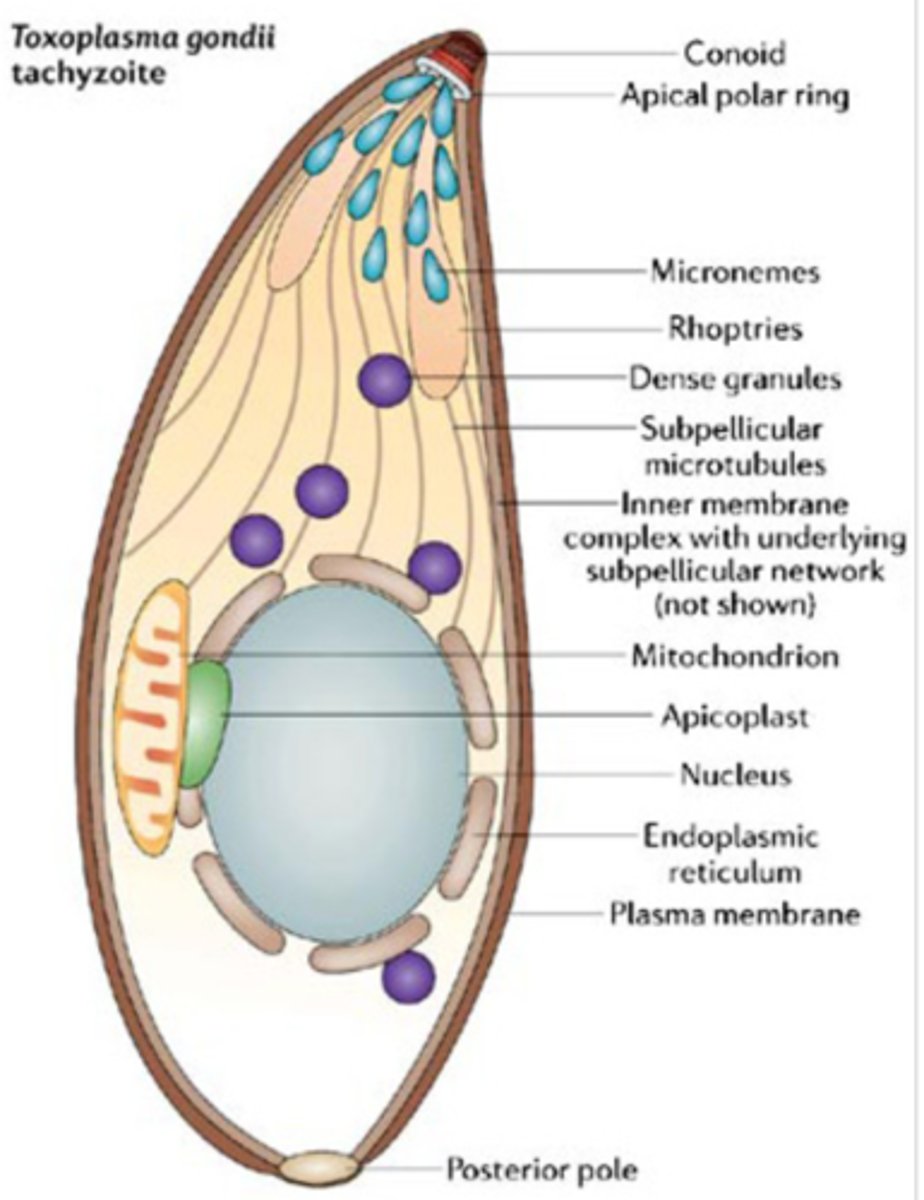
Eimeria and cryptosporidium belongs to?
subphylum apicomplexa, class coccidea
What parasites are monoxenous/which genera belong to monoxenous coccidiae?
Monoxenous: life cycle in one host.
- Eimeria Cryptosporidia
- Eimeria Isospora
Where does gamogony, sporogony and merogony take place in eimeria?
Sporogony: external environment (exogenous)
Merogony and Gamogony: small intestine (endogenous)
Where is eimeria truncate located?
Kidney of geese
Where is eimeria stiedai located?
Liver of rabbit (bile duct epithelium)
Schizogony eimeria intricate begins in?
Ileum enterocytes in sheep
Which genera belongs to monoxenous coccidia?
Eimeria,
Cryptosporidium,
isospora
Where does sporogony occur in Eimeria?
exogenous: external environment
Sporogony of cryptosporidium spp. occur in?
- Endogenous: inside final host.
- small intestine
Size of Cryptosporidium?
5-7 micrometer
Size of Eimeria:
20-25 micrometer
What are species of cryptosporidium?
- C. Parvum
- C. Muris
- C. Baylei
- C. Meleagridis
What cryptosporidium parasites are typical in birds/poultry?
- C. Baylei
- C. meleagridis
Cryptosporidium Baylei occurs often in?
poultry, resp tract
Cryptosporidium parvum occurs often in?
cattle, <1month
Pathology of cryptosporidium, how is it diagnosed?
Watery, acute diarrhea
Diagnosis:
- Fecal smear,
- Stained fecal smear (carbo-fuchine staining, kinyoun stain, ziehl-nielsen stain),
- Detection of coproantigen (rapid test, ELISA, PCR, scraping of trachea)
Three types of stained fecal smear?
- Carbo-fuchine stain
- kinyoun stain
- ziehl-neelsen stain
Eimeria parasites in chicken:
- E. tenella
- E. necatrix (Small Intestine)
Eimeria parasites in geese:
E. Truncata (kidney)
Eimeria parasites in rabbit:
E. stiedai,
E. Intestinalis,
E. flavescens
Eimeria parasites in cattle:
- E. zuernii,
- E. Bovis
Life cycle of Cryptosporidium?
1. Sporogony: Zygoite becomes thin shelled oocyst (20%) or thick shelled oocyst (80%). Thick shelled is secreted through feces, thin shelled stays in small intestine.
2. thin shelled oocyst releases sporozoites thorugh Excystation. Released sporozoite attaches to enterocyte => meronts.
3. Inside meronts are Merozoites that through merogony (asexuall reproduction) replicate.
4, Cell bursts. releasing merozoites.
5. merozoites can infect new endocytes or become mikrogametes (male) or makrogametes (female).
6. Gamogony (sexuall reproduction: mikro and makrogametes fuse = Zygoite
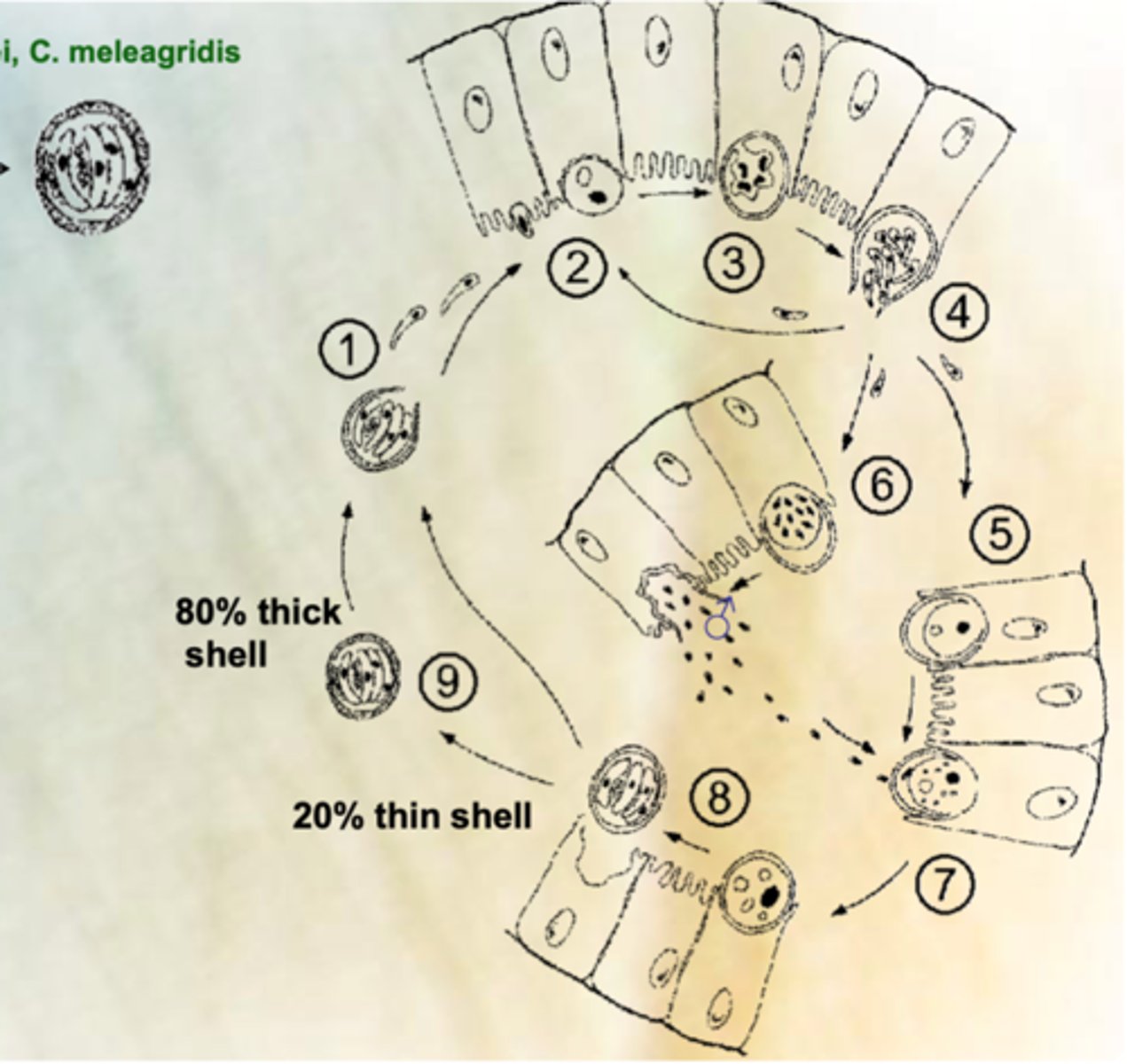
Life cycle of Eimeria:
1. Sporogony: HAPPENS IN EXTERNAL ENVIRONMENT:
Zygoite oocyst
2. INGESTED BY HOST: oocyst releases sporozoites thorugh Excystation. Released sporozoit attaches to enterocyte => meronts.
3. Inside meronts are Merozoites that through merogony (asexuall reproduction) replicate.
4, Cell bursts. releasing merozoites.
5. merozoites can infect new endocytes or become mikrogametes (male) or makrogametes (female).
6. Gamogony (sexuall reproduction: mikro and makrogametes fuse = Zygoite
7. Zygoite excreted through feces
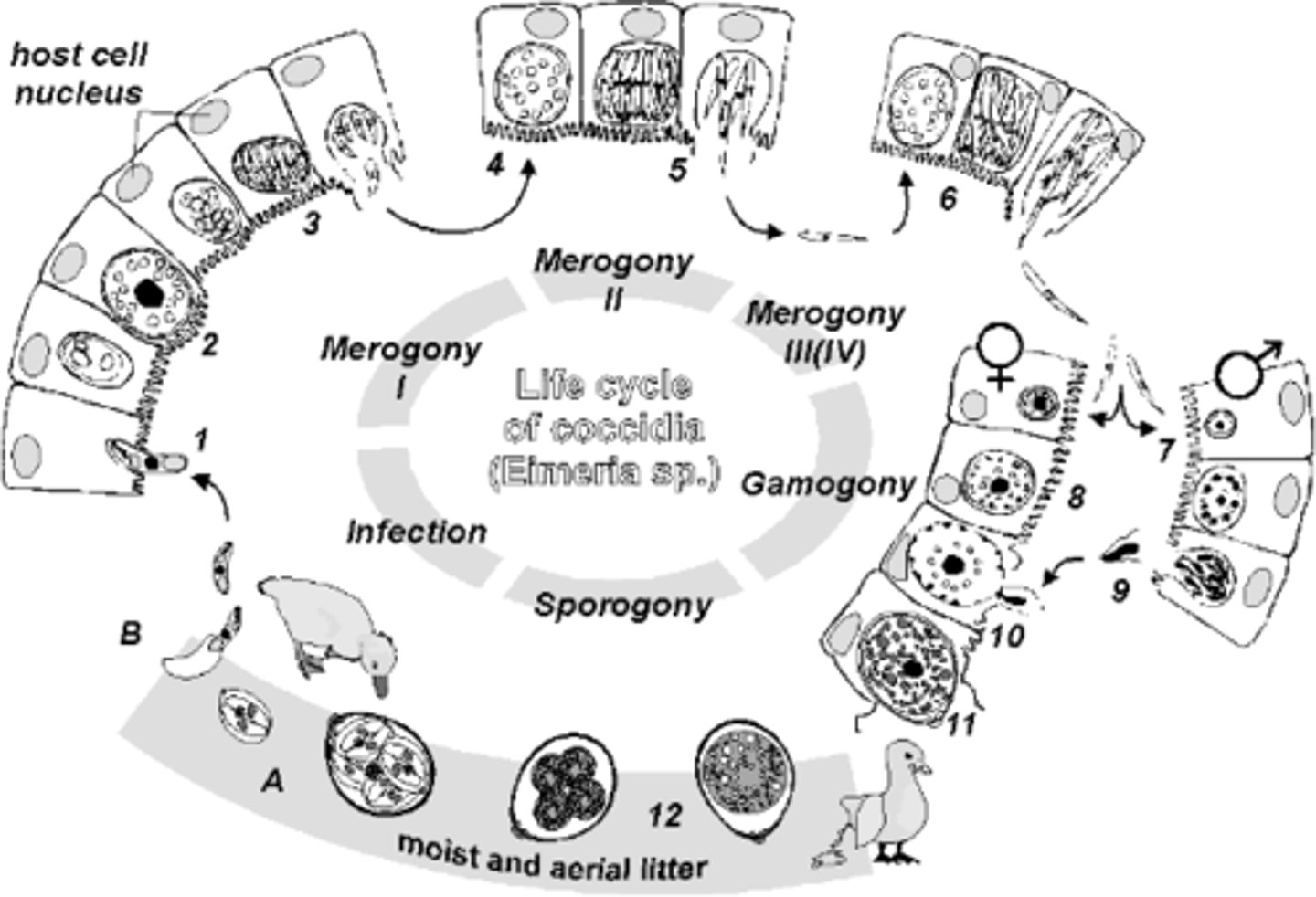
Draw Eimeria and describe
- Unsporulated or Sporulated: (4 sporocyst, 8 sporozoites)
- 5-7 micrometer
- Oval
- Thin shell
- Light yellow
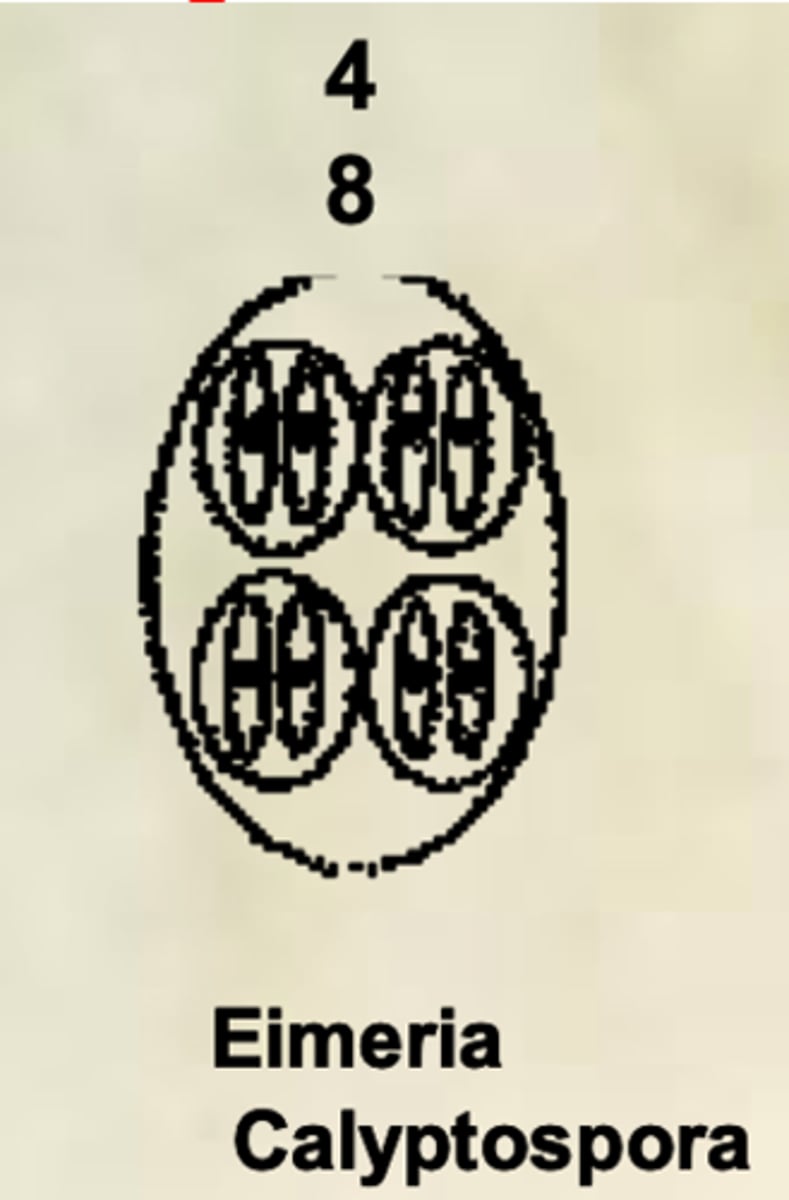
Fully sporulated oocysts were found in the feces of rabbit. What species is most likely represented? name and describe it:
Eimeria stiedai.
- 4 sporocysts
- 8 sporozoites (2 in each sporocyst)
- Small
- Oval
- 2 thin shells
- Sporulated or unsporulated
- Transparent
What does sporolated oocysts in cryptosporidium spp. look like?
- 0 sporocysts
- 4 sporozoits (free)
- No micropyle
- Microgametes have no flagellum
- 5-7 micrometer (small)
- Oval/Round
- 2 thin shells
- Pink on Ziehl Nielsen stain
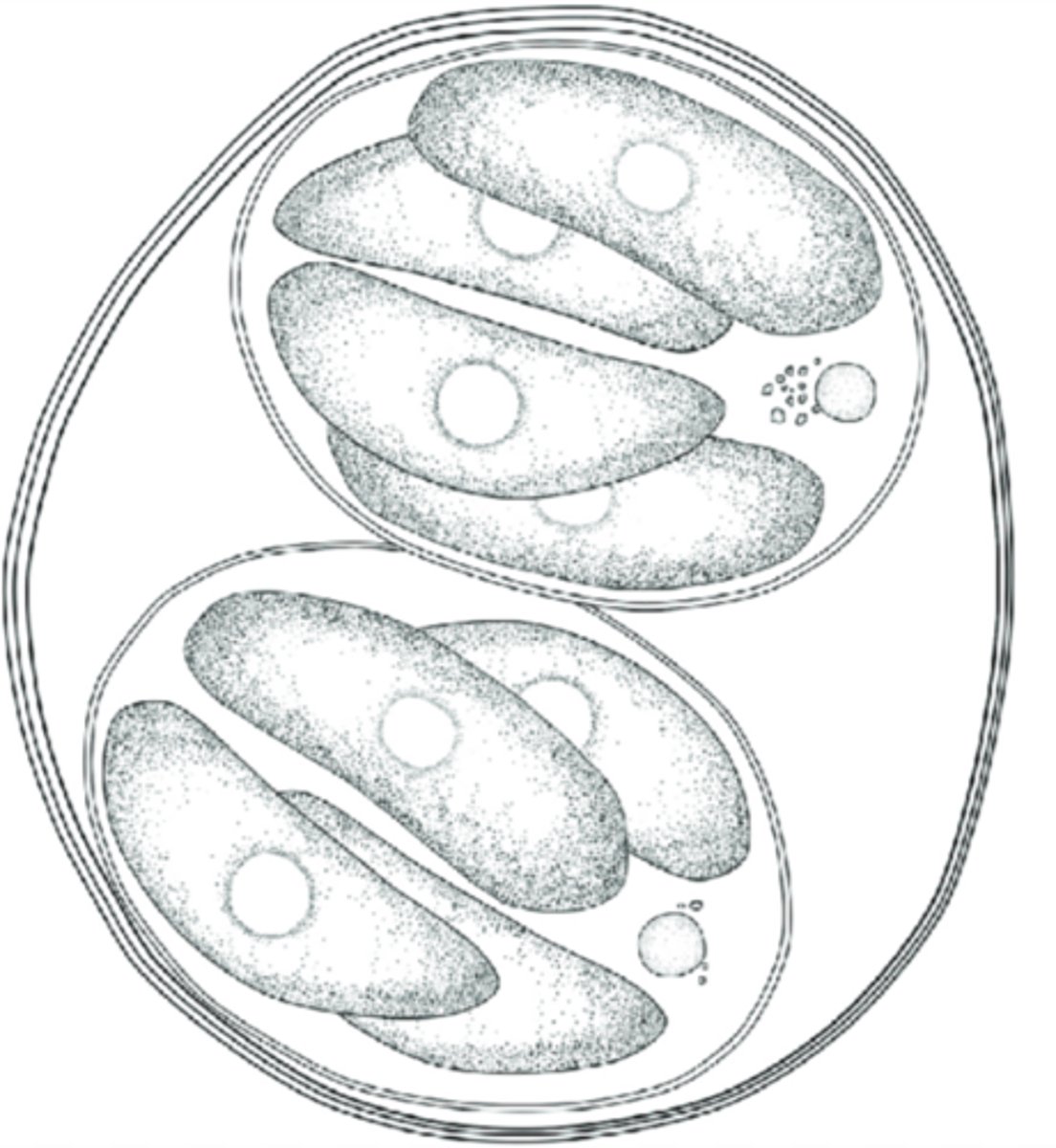
Draw oocyst of Eimeria, Cryptosporidium and Cystoisospora:
Eimeria:
4 sporocysts,
8 sporozoites
Cryptosporidium:
0 sporocysts,
4 sporozoites
Cystoisospora:
2 sporocysts,
8 sporozoites